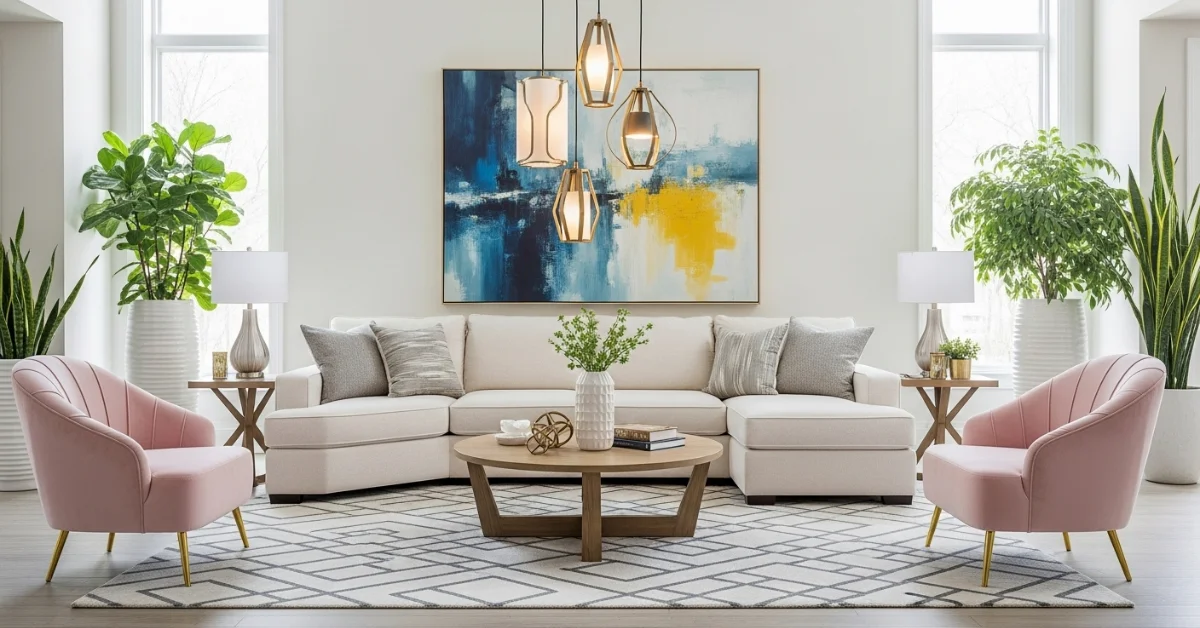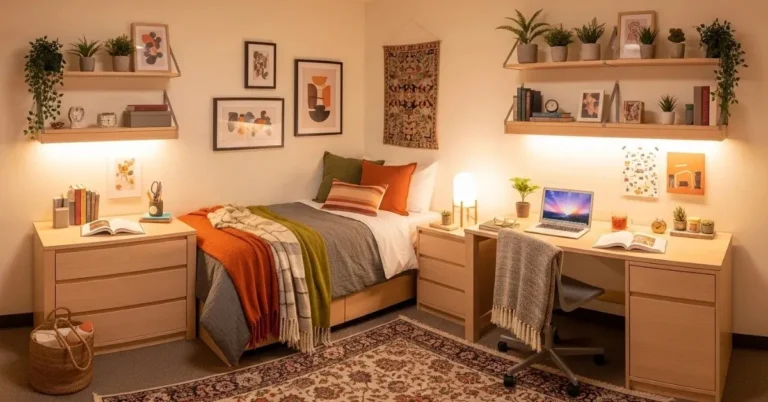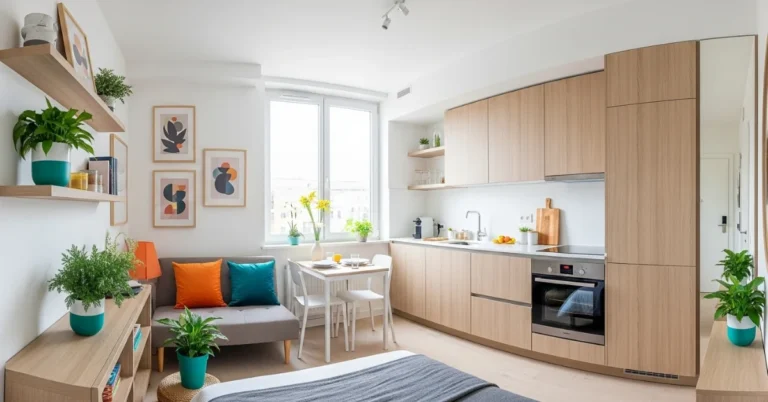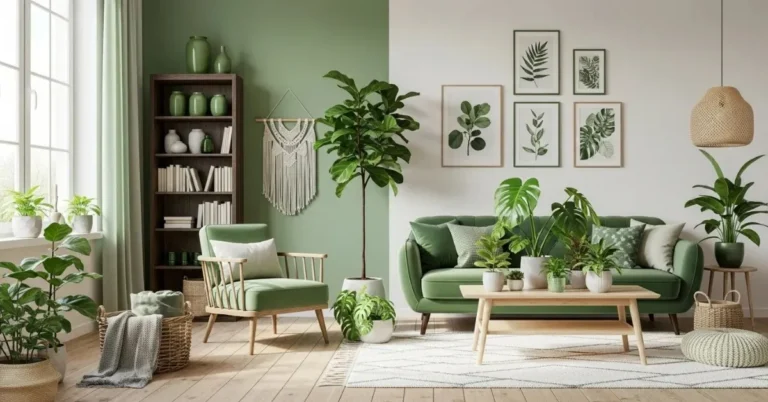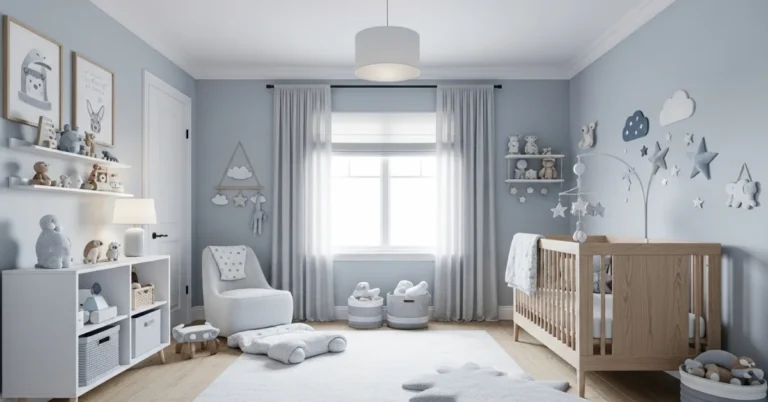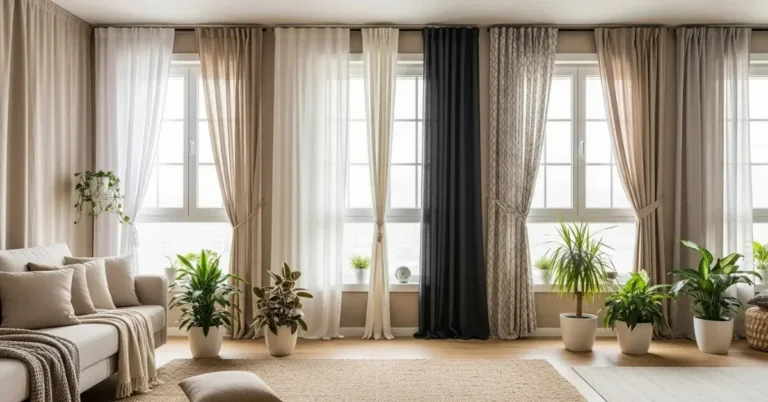19 Living Room Design Ideas to Instantly Transform a Boring Space
When you’re searching for 19 living room design ideas, you want real solutions that make your space feel warm, stylish, and totally yours. Your living room isn’t just furniture and walls—it’s where your family gathers after dinner, where friends laugh over coffee, and where you finally relax after long days. This article shares practical design approaches that work for real homes, real budgets, and real people who want their living rooms to feel special without breaking the bank.
1. Embrace Minimalist Scandinavian Style
Sarah from Portland transformed her cluttered living room into a peaceful retreat by adopting Scandinavian design principles. She removed half her furniture, painted the walls soft white, and added just three carefully chosen pieces: a beige sofa, a wooden coffee table, and a simple floor lamp.

The beauty of this style lies in its simplicity. Light wood tones, neutral colors like cream and gray, and clean lines create spaces that feel bigger and calmer. You don’t need expensive items—just focus on quality over quantity, and let natural light do most of the work.
2. Create a Cozy Cottage Core Atmosphere
Michael in Vermont brought cottage core magic into his 1990s apartment by adding vintage touches everywhere. He found a floral armchair at a thrift store for $40, hung dried flowers from his grandmother’s garden, and placed soft throw blankets on every seating spot.

This design idea works perfectly if you love warmth and nostalgia. Think patterns with flowers, furniture that looks lived-in, and colors like soft green, dusty pink, and cream. Add some old books on shelves, display family photos in mismatched frames, and suddenly your living room feels like a countryside escape.
3. Go Bold with Maximalist Colors
When Jenny moved to Miami, she decided boring beige walls weren’t for her anymore. She painted one wall deep emerald green, added a bright orange velvet sofa, and mixed in purple cushions without any fear.

Maximalism celebrates personality through color explosions. Don’t worry about matching perfectly—the goal is layering different shades, patterns, and textures until your room feels alive. This approach works especially well for creative people who want their space to reflect their bold spirit.
4. Design an Industrial Loft Look
Carlos converted his living room in Chicago to industrial style by exposing the brick wall his landlord had covered with drywall. He added metal shelving units, kept the concrete floor visible, and hung Edison bulb lights from black fixtures.

Industrial design brings urban edge into homes through raw materials. Look for furniture with metal frames, leave pipes or beams visible if you have them, and stick with neutral colors like black, gray, and brown. This style works beautifully in older buildings or apartments with high ceilings.
5. Incorporate Biophilic Design Elements
Rebecca’s Seattle apartment barely got sunlight, so she filled her living room with plants to bring nature indoors. She placed a tall fiddle leaf fig tree near the window, added hanging pothos vines, and covered surfaces with small succulents.

Biophilic design connects humans with nature through living elements. Research shows that rooms with plants reduce stress by up to 37% and improve air quality. Start with easy-care plants like snake plants or spider plants, add natural wood furniture, and use earth-tone colors to complete the look.
6. Add Smart Home Technology
Kevin in San Francisco upgraded his living room with voice-controlled lights, a smart thermostat, and motorized curtains that open automatically each morning. His favorite addition was the entertainment system he controls entirely from his phone.

Smart technology makes living rooms more functional without changing their style. You can adjust lighting to match your mood, play music in every corner, or set the perfect temperature before you even get home. Most smart devices install easily and connect through apps on your phone.
7. Choose Mid-Century Modern Furniture
Angela found her dream sofa at a vintage store in Austin—a genuine 1960s piece with tapered wooden legs and teal upholstery. She paired it with a geometric rug and a starburst clock to complete her mid-century modern living room.
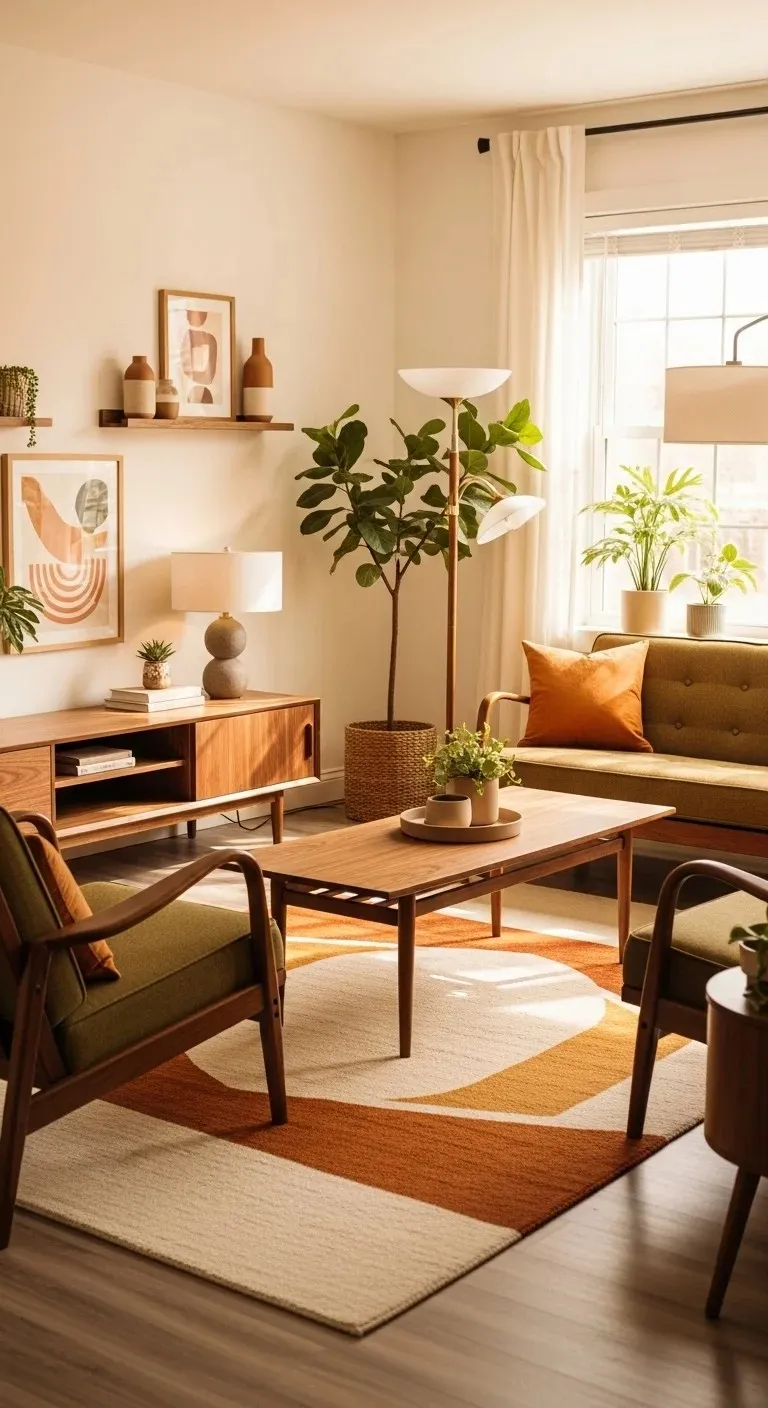
This timeless style features furniture with clean lines, organic curves, and functionality. Look for pieces with wooden legs that angle outward, choose colors like mustard yellow, teal, or burnt orange, and add abstract art to your walls. Mid-century modern works in apartments and houses of any size.
8. Install a Statement Wall Treatment
David couldn’t afford to renovate his entire living room in Boston, so he focused on one wall instead. He installed wooden planks horizontally across the wall behind his TV, stained them dark walnut, and suddenly the whole room looked expensive.

Statement walls become focal points that draw every eye. You might choose wallpaper with bold patterns, create a gallery wall with family photos, or paint one wall a dramatic color while keeping others neutral. This approach adds personality without overwhelming your space.
9. Layer Different Lighting Sources
Maria’s living room in Denver felt cold until she realized she only had one overhead light. She added a tall reading lamp beside her chair, placed two table lamps on side tables, and hung string lights near the window.

Good lighting design uses three types: ambient lighting for overall brightness, task lighting for specific activities, and accent lighting for mood. Avoid relying on just ceiling lights—they create harsh shadows. Instead, spread multiple light sources around the room at different heights for warmth and depth.
10. Mix Vintage and Modern Pieces
James loves combining old and new in his Nashville living room. His sleek modern sofa sits next to his grandfather’s vintage trunk, which now serves as a coffee table. Above the sofa hangs a contemporary abstract painting, while an antique mirror leans against the opposite wall.
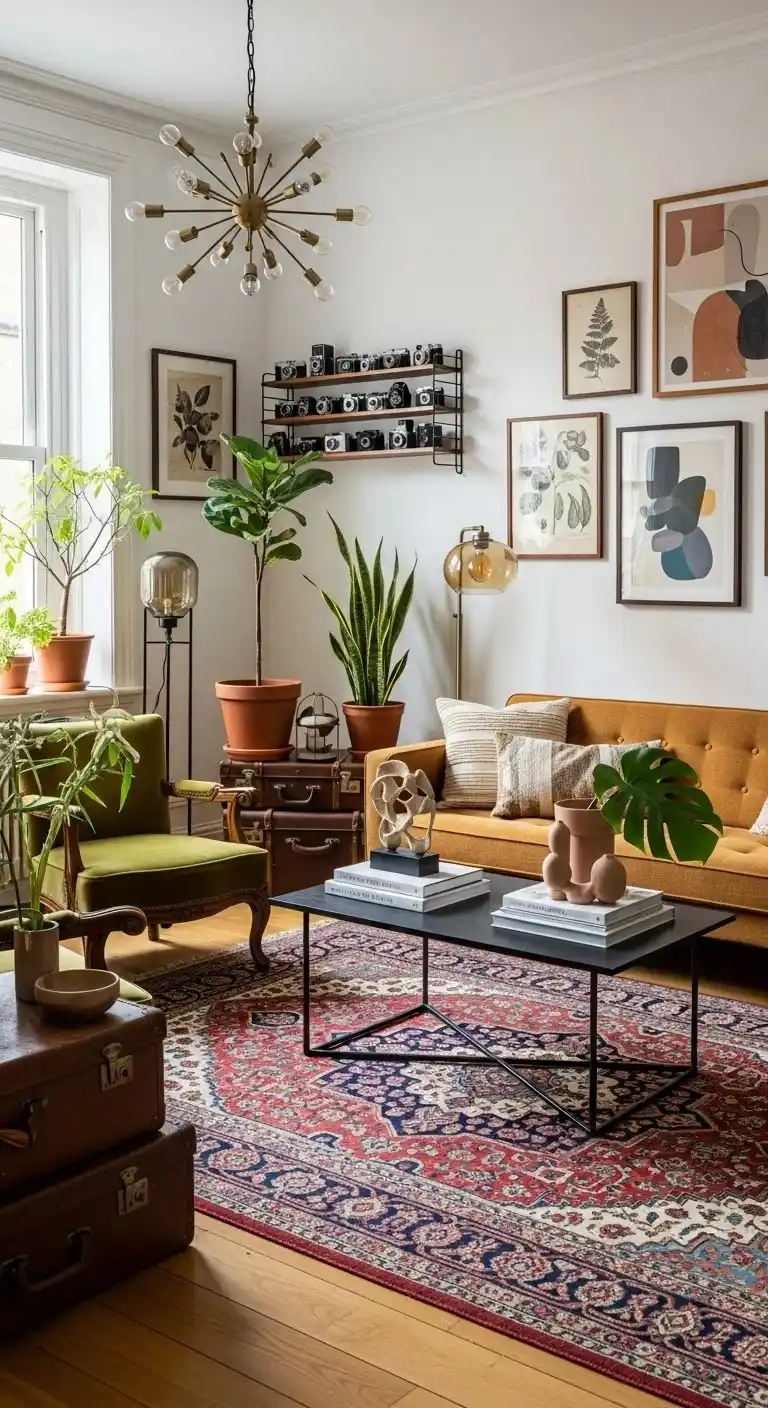
This eclectic approach prevents rooms from feeling like furniture showrooms. Visit flea markets for unique vintage finds, then balance them with clean-lined modern pieces. The contrast creates visual interest and tells the story of your personal taste rather than following strict design rules.
11. Create Conversation Zones
When Lisa hosts her book club in Phoenix, everyone sits comfortably because she arranged her furniture to encourage talking. Instead of lining everything against walls, she pulled her sofa and chairs into a circle facing each other, with the coffee table in the middle.
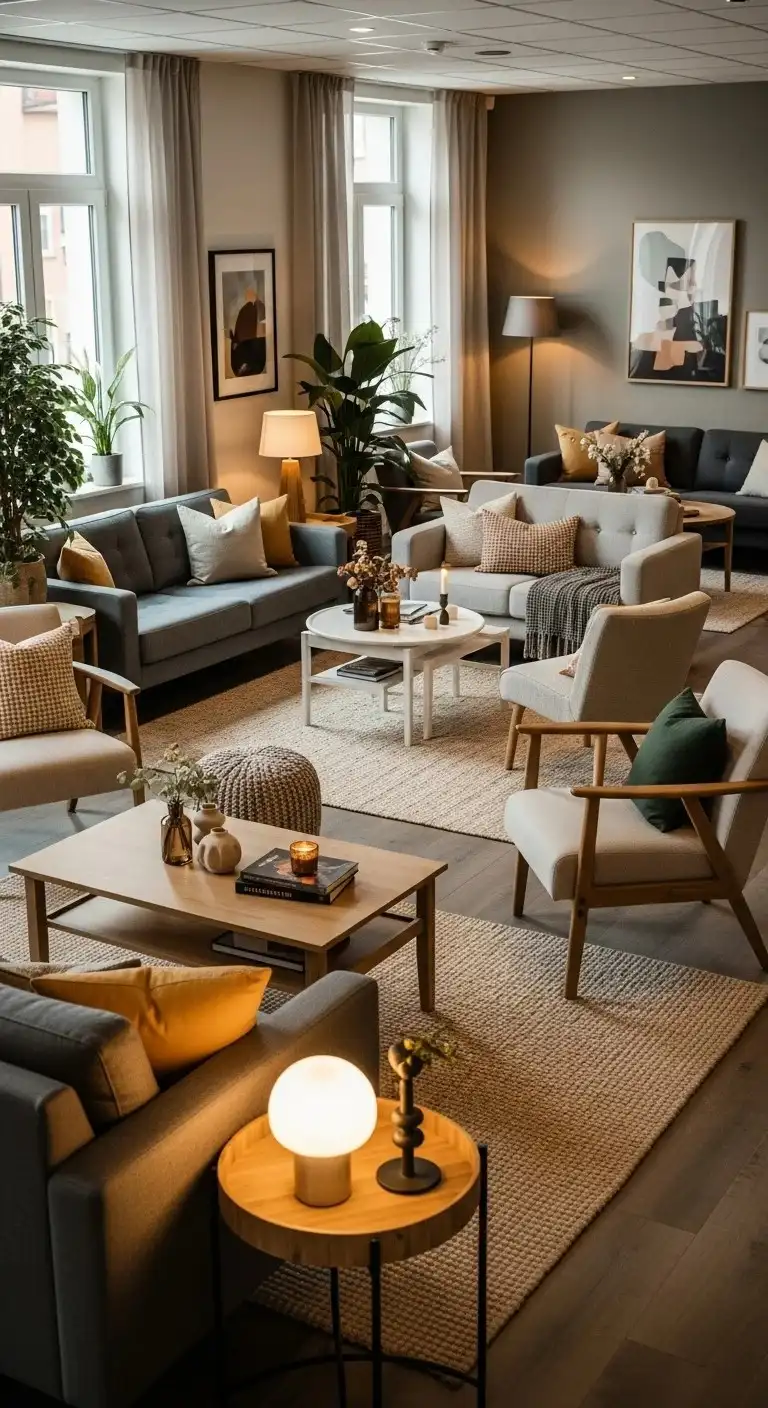
Conversation zones work by placing seating within 8 feet of each other so people can chat easily without shouting. Angle chairs toward each other rather than toward the TV, and make sure everyone has a place to set their drink. This setup makes gatherings feel more intimate and connected.
12. Use Multipurpose Furniture
Tom’s studio apartment in New York needed smart solutions since his living room also serves as his bedroom. He bought an ottoman that opens for storage, a sofa bed for guests, and a coffee table that lifts up to become a desk when he works from home.

Multipurpose furniture maximizes small spaces beautifully. Consider benches with storage underneath, nesting tables you can spread out when needed, or wall-mounted desks that fold away. These pieces help you live comfortably without sacrificing style or function.
13. Incorporate Textured Fabrics
Emma’s living room in Chicago felt flat until she started layering textures. She draped a chunky knit blanket over her leather sofa, added velvet cushions in jewel tones, and placed a jute rug under the coffee table.

Texture creates depth that paint colors alone cannot achieve. Mix smooth fabrics like silk with rough ones like linen, combine soft materials like velvet with structured ones like leather, and layer different weaves in your rugs and throws. Your eyes notice these variations even when colors match.
14. Display Personal Collections
Marcus turned his stamp collection into art by framing his rarest stamps and hanging them in a grid on his living room wall in Atlanta. His guests always ask about them, and the display makes his space feel uniquely his.

Personal collections become conversation starters when displayed thoughtfully. Whether you collect vinyl records, vintage cameras, or travel souvenirs, give them prominent space rather than hiding them away. Use floating shelves, shadow boxes, or glass cabinets to showcase items you love.
15. Paint an Accent Ceiling
When Rachel couldn’t decide on wall colors for her living room in Charleston, her designer suggested painting the ceiling instead. She chose a soft blush pink that makes the room feel cozy, and everyone who visits looks up in surprise.
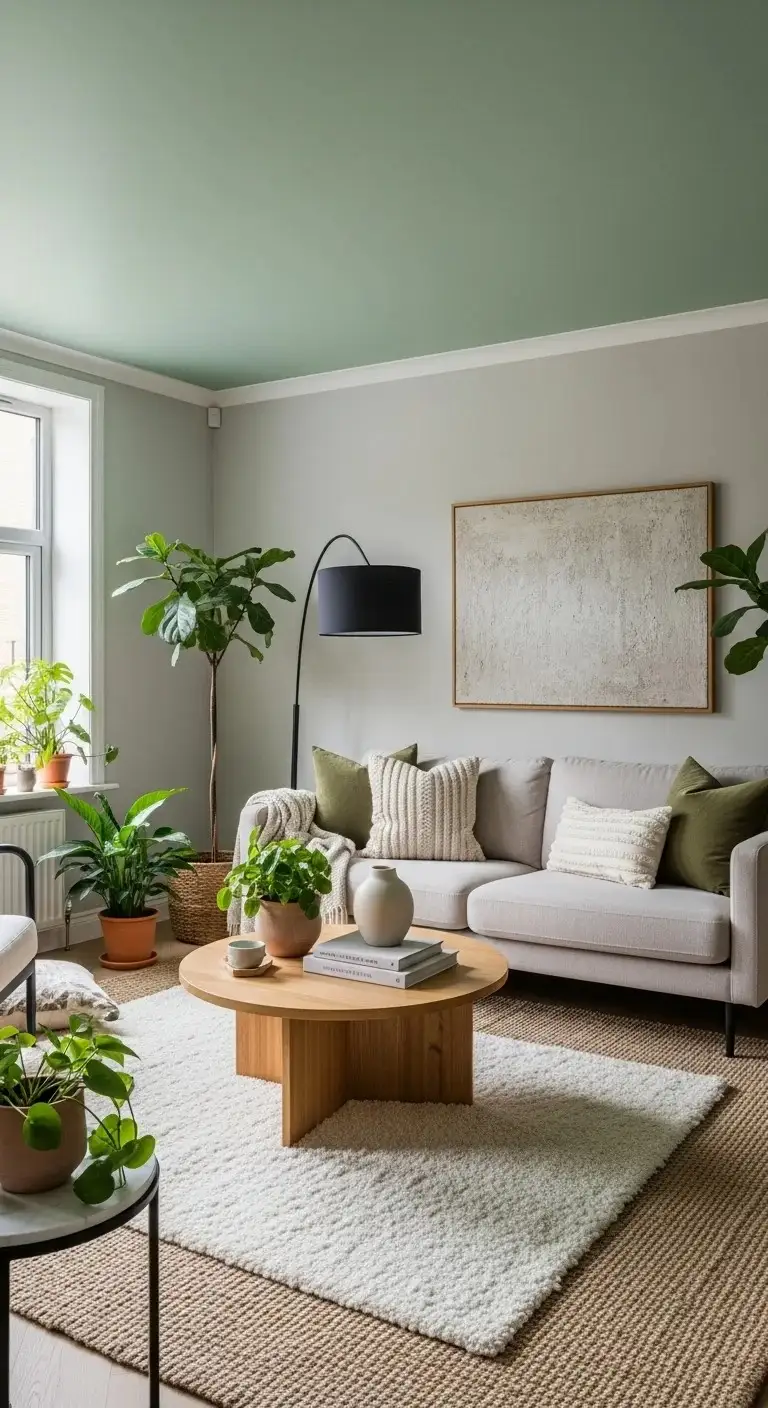
Accent ceilings add drama to spaces where wall colors might compete with art or furniture. Try painting your ceiling a shade darker than your walls for coziness, or choose a bold color for personality. This unexpected approach works especially well in rooms with architectural details like crown molding or beams.
16. Arrange Symmetrical Layouts
The Roberts family in Philadelphia created balance in their living room by placing matching table lamps on both sides of their sofa, hanging identical mirrors flanking their fireplace, and choosing two matching armchairs across from the sofa.

Symmetrical arrangements feel calming and organized because our brains find comfort in balance. This approach works beautifully in formal living rooms or spaces where you want to create a sense of order. Just make sure to add a few asymmetrical elements to prevent the room from feeling too stiff.
17. Add Architectural Details
Paul’s builder-grade apartment in Dallas felt generic until he installed crown molding around the ceiling and wainscoting on the lower half of his walls. These details only cost him $200 in materials and a weekend of work.
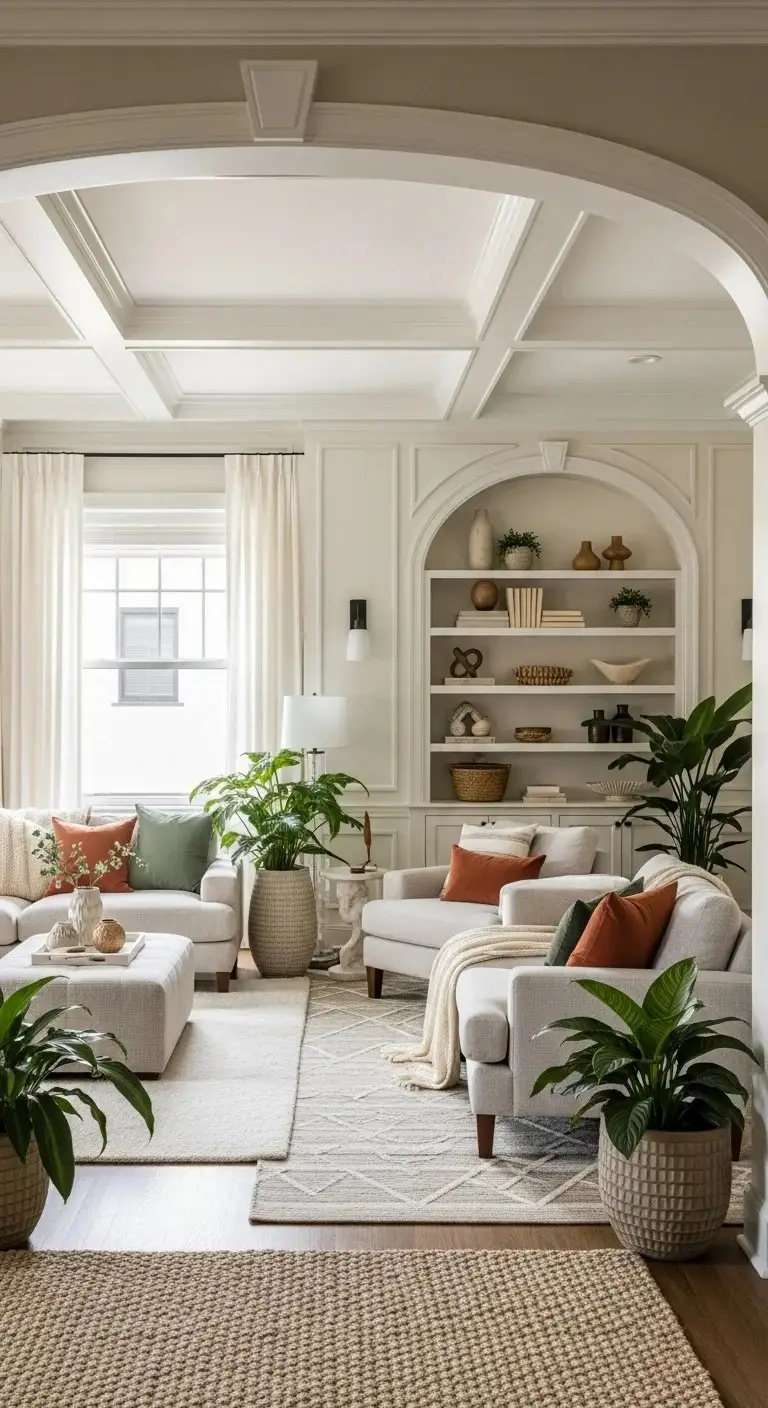
Architectural details like molding, built-in shelving, or decorative columns give rooms character and make them feel custom. If you rent and cannot install permanent features, consider removable options like faux beams, temporary wallpaper that mimics paneling, or large-scale art that creates architectural presence.
18. Choose a Monochromatic Color Scheme
Zoe’s living room in San Diego uses only shades of blue—from pale sky blue walls to navy accent chairs to turquoise accessories. The cohesive palette makes her small space feel larger and more sophisticated than it did with mixed colors.
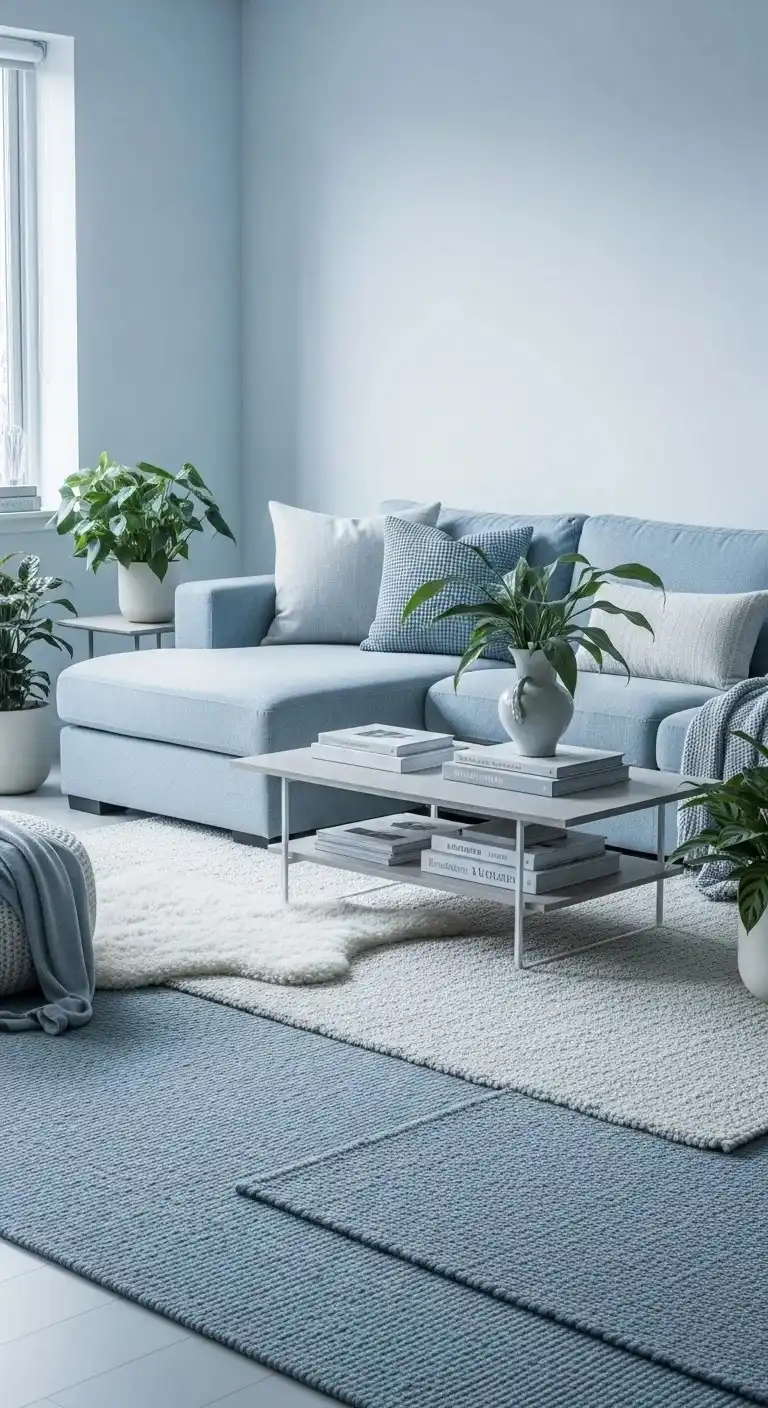
Monochromatic design uses variations of one color to create harmony. This approach works perfectly if you feel overwhelmed by color combinations. Pick your favorite color, then use its lighter tints and darker shades throughout furniture, walls, and accessories. Add different textures to prevent the space from feeling flat.
19. Incorporate Cultural Elements
When Priya designed her living room in Houston, she hung traditional Indian textiles as wall art, placed brass figurines from her grandmother’s house on the mantel, and chose furniture with carved wooden details that reminded her of home.
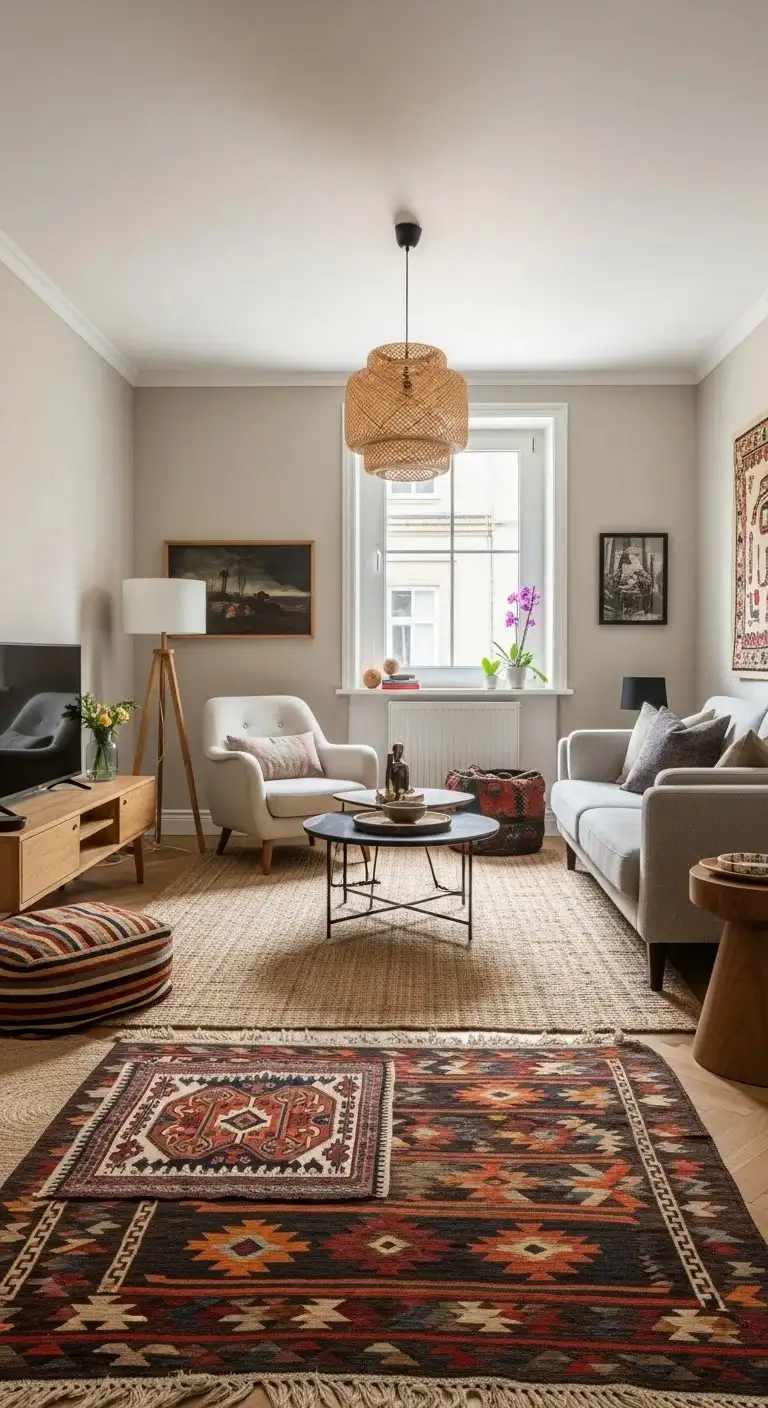
Cultural elements make living rooms feel personal and meaningful. Whether you display African masks, Mexican pottery, or Japanese scrolls, these pieces tell your family’s story. Mix cultural items with modern furniture to create spaces that honor heritage while feeling current and livable.
Key Statistics About Living Room Design
According to the National Association of Home Builders, 87% of homebuyers rate the living room as the most important space when purchasing a home
- A 2024 Houzz study found that 64% of homeowners who renovate start with their living room
- Interior designers report that proper lighting can increase a room’s perceived size by up to 20%
- Homes with well-designed living rooms sell 15% faster than those without, according to real estate data from 2024
Conclusion
Your living room deserves design that makes you happy every single day, not just when guests visit. These 19 living room design ideas work because they come from real people solving real problems in their actual homes. Start with one idea that excites you most, try it out, and see how it feels. Design isn’t about perfection—it’s about creating a space where your life happens comfortably and beautifully. Trust your instincts, have fun experimenting, and remember that the best living room is the one where you actually want to spend time.
Frequently Asked Questions
What is the best color for a small living room?
Light colors like white, soft gray, pale blue, or cream make small living rooms feel larger because they reflect more light. Paint your walls and ceiling the same light shade to blur boundaries and create the illusion of more space. Add darker colors through furniture and accessories for depth without making the room feel closed in.
How do I arrange furniture in a small living room?
Float your sofa away from the wall instead of pushing it against the edges, which actually creates more usable space. Choose furniture with exposed legs so you can see the floor underneath—this visual trick makes rooms appear larger. Use multipurpose pieces like ottomans with storage and avoid blocking pathways between doorways.
What lighting is best for living rooms?
Layer three types of lighting for the best results: overhead ambient lighting for general brightness, task lighting like reading lamps for specific activities, and accent lighting such as wall sconces for mood. Use warm-colored bulbs (2700-3000K) rather than cool white bulbs to create a cozy, inviting atmosphere that makes people want to relax.
How can I make my living room look expensive on a budget?
Focus on a few key upgrades that create big visual impact: paint walls a sophisticated color, add crown molding or architectural details, invest in one quality statement piece like a beautiful rug or sofa, and declutter ruthlessly. Good lighting and fresh plants also make spaces look more expensive without costing much money.RetryClaude can make mistakes. Please double-check responses.
